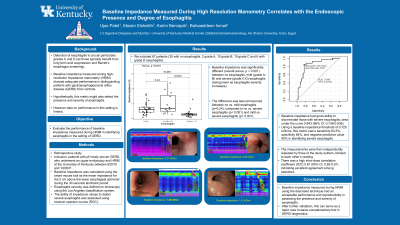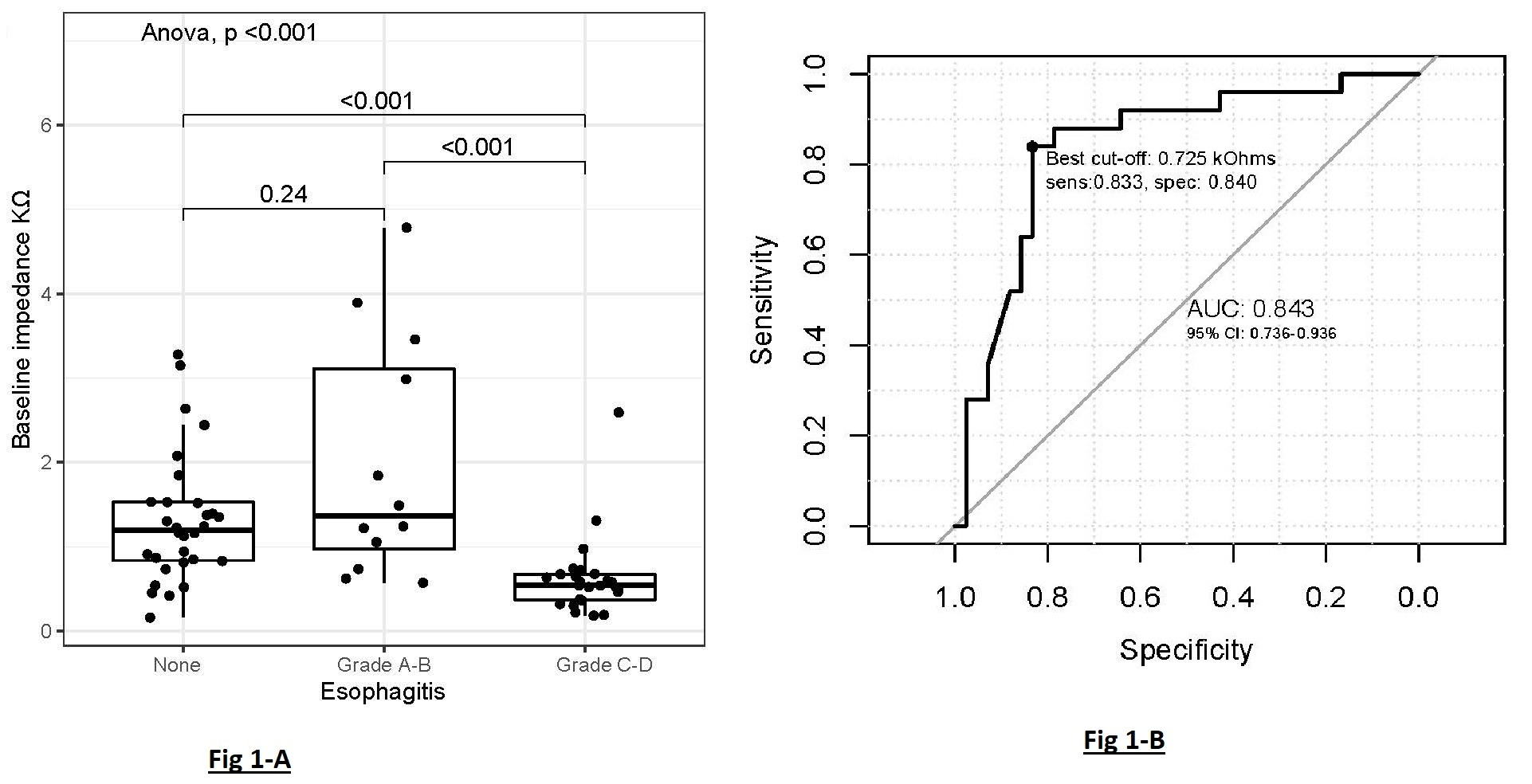Back


Poster Session B - Monday Morning
Category: Esophagus
B0203 - Baseline Impedance Measured During High Resolution Manometry Correlates With the Endoscopic Presence and Degree of Esophagitis
Monday, October 24, 2022
10:00 AM – 12:00 PM ET
Location: Crown Ballroom

Has Audio
- BI
Bahaaeldeen Ismail, MD
University of Kentucky
Lexington, KY
Presenting Author(s)
Ujas Patel, MD1, Mazen Elsheikh, MBBCh2, Karim Benrajab, MD1, Bahaaeldeen Ismail, MD1
1University of Kentucky, Lexington, KY; 2Ain Shams University, Cairo, Al Qahirah, Egypt
Introduction: Baseline impedance measured during high-resolution impedance manometry (HRIM) showed adequate performance in distinguishing patients with gastroesophageal acid reflux disease (GERD) from controls. Hypothetically, this metric might also detect the presence and severity of esophagitis, however data is limited. We investigated the performance of baseline impedance measured during HRIM in identifying esophagitis, particularly grades C and D (as those typically benefit from long term acid suppression and Barrett’s esophagus screening).
Methods: This is a retrospective study including patients with pH study proven GERD, who underwent an upper endoscopy and HRIM at the University of Kentucky between 9/2015 and 10/2021. Baseline impedance was calculated using the smart mouse tool as the mean impedance for the 3 cm above the lower esophageal sphincter during the 30 seconds landmark period. Esophagitis severity was defined on endoscopy using the Los Angeles classification system. The ability of impedance values to detect severe esophagitis was assessed using receiver operator curves (ROC).
Results: We included 67 patients (30 with no esophagitis, 2 grade A, 10 grade B, 19 grade C and 6 with grade D esophagitis). Baseline impedance were significantly different (overall anova, p < 0.001) between no esophagitis, mild (grade A-B) and severe (grade C-D) esophagitis (being lower as esophagitis severity increases). The difference was less pronounced between no vs. mild esophagitis (p=0.24), compared to no vs. severe esophagitis (p< 0.001) and mild vs. severe esophagitis (p< 0.001) – figure 1-A. The ROC analysis (figure 2-B) showed that the baseline impedance had good ability to discriminate those with severe esophagitis; area under the curve 0.843 (95% CI: 0.736-0.936). Using a baseline impedance threshold of 0.725 kOhms, this metric had a sensitivity 83.3%, specificity 84%, and negative predictive value 90% in identifying severe esophagitis. The baseline impedance measurements were then independently repeated by three of the study authors, blinded to each other’s reading. The measurements had high intra-class correlation coefficient (ICC) 0.87 (95% CI: 0.82-0.91) indicating excellent agreement among operators.
Discussion: Baseline impedance measured during HRIM using the described technique had an acceptable performance and reproducibility in assessing the presence and severity of esophagitis. After further validation, this can serve as a rapid, less invasive complementary tool in GERD diagnostics.

Disclosures:
Ujas Patel, MD1, Mazen Elsheikh, MBBCh2, Karim Benrajab, MD1, Bahaaeldeen Ismail, MD1. B0203 - Baseline Impedance Measured During High Resolution Manometry Correlates With the Endoscopic Presence and Degree of Esophagitis, ACG 2022 Annual Scientific Meeting Abstracts. Charlotte, NC: American College of Gastroenterology.
1University of Kentucky, Lexington, KY; 2Ain Shams University, Cairo, Al Qahirah, Egypt
Introduction: Baseline impedance measured during high-resolution impedance manometry (HRIM) showed adequate performance in distinguishing patients with gastroesophageal acid reflux disease (GERD) from controls. Hypothetically, this metric might also detect the presence and severity of esophagitis, however data is limited. We investigated the performance of baseline impedance measured during HRIM in identifying esophagitis, particularly grades C and D (as those typically benefit from long term acid suppression and Barrett’s esophagus screening).
Methods: This is a retrospective study including patients with pH study proven GERD, who underwent an upper endoscopy and HRIM at the University of Kentucky between 9/2015 and 10/2021. Baseline impedance was calculated using the smart mouse tool as the mean impedance for the 3 cm above the lower esophageal sphincter during the 30 seconds landmark period. Esophagitis severity was defined on endoscopy using the Los Angeles classification system. The ability of impedance values to detect severe esophagitis was assessed using receiver operator curves (ROC).
Results: We included 67 patients (30 with no esophagitis, 2 grade A, 10 grade B, 19 grade C and 6 with grade D esophagitis). Baseline impedance were significantly different (overall anova, p < 0.001) between no esophagitis, mild (grade A-B) and severe (grade C-D) esophagitis (being lower as esophagitis severity increases). The difference was less pronounced between no vs. mild esophagitis (p=0.24), compared to no vs. severe esophagitis (p< 0.001) and mild vs. severe esophagitis (p< 0.001) – figure 1-A. The ROC analysis (figure 2-B) showed that the baseline impedance had good ability to discriminate those with severe esophagitis; area under the curve 0.843 (95% CI: 0.736-0.936). Using a baseline impedance threshold of 0.725 kOhms, this metric had a sensitivity 83.3%, specificity 84%, and negative predictive value 90% in identifying severe esophagitis. The baseline impedance measurements were then independently repeated by three of the study authors, blinded to each other’s reading. The measurements had high intra-class correlation coefficient (ICC) 0.87 (95% CI: 0.82-0.91) indicating excellent agreement among operators.
Discussion: Baseline impedance measured during HRIM using the described technique had an acceptable performance and reproducibility in assessing the presence and severity of esophagitis. After further validation, this can serve as a rapid, less invasive complementary tool in GERD diagnostics.

Figure: Figure 1-A: Boxplots demonstrating individual data points, median and interquartile range for baseline impedance among the esophagitis subgroups. Figure 1-B: Receiver operating characteristic curve of baseline impedance to discriminate severe esophagitis (C-D) from those with mild / no esophagitis.
anova: Analysis of Variance; AUC: area under the curve; CI: confidence interval
*confidence interval was calculated using 1000 stratified bootstrap replicates.
anova: Analysis of Variance; AUC: area under the curve; CI: confidence interval
*confidence interval was calculated using 1000 stratified bootstrap replicates.
Disclosures:
Ujas Patel indicated no relevant financial relationships.
Mazen Elsheikh indicated no relevant financial relationships.
Karim Benrajab indicated no relevant financial relationships.
Bahaaeldeen Ismail indicated no relevant financial relationships.
Ujas Patel, MD1, Mazen Elsheikh, MBBCh2, Karim Benrajab, MD1, Bahaaeldeen Ismail, MD1. B0203 - Baseline Impedance Measured During High Resolution Manometry Correlates With the Endoscopic Presence and Degree of Esophagitis, ACG 2022 Annual Scientific Meeting Abstracts. Charlotte, NC: American College of Gastroenterology.

